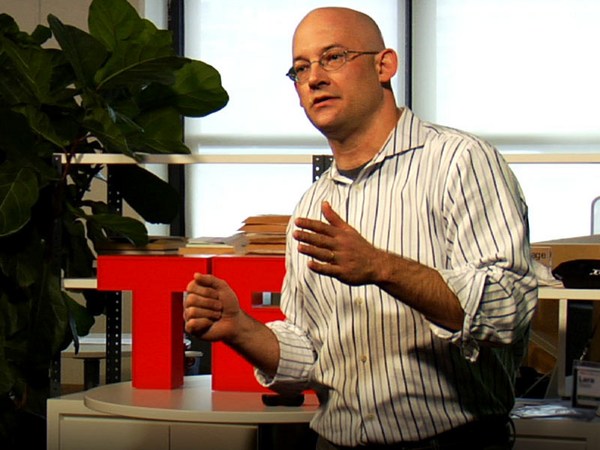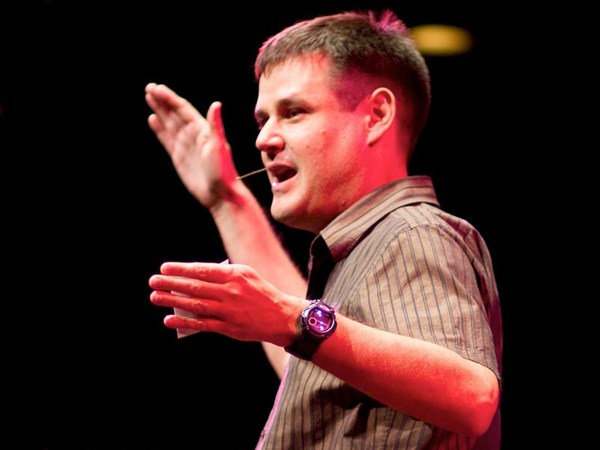Thank y'all!
This is going to be a motivational speech. Because -- imagine my motivation standing between this strong, healthy crowd ... and lunch.
(Laughter)
So ... I'm @Falkvinge on Twitter. Feel free to quote me if I say something memorable, stupid, funny, whatever. I love seeing my name on Twitter.
So ... Hi! I'm Rick. I'm a politician. I'm sorry. How many in here have heard of the Swedish Pirate Party before? Let's see a show of hands. OK, that's practically everybody. Probably due to the fact that we are Sweden's neighbor.
I frequently ask how many have heard of any other political party and there's always just scattered hands in the audience compared to this first question which is one-half to two-thirds. This is actually the first time ever that does not match. It was practically everybody.
So, for those who haven't heard of us: well, the Pirate Party, we love the net. We love copying and sharing, and we love civil liberties. For that, some people call us pirates. Probably in an attempt to make us bow our heads and feel shame. That didn't work very well. We decided to stand tall about it instead.
And so in 2006, I founded a new political party. I led it for its first five years. And the European elections, the last European elections, we became the largest party and the most coveted youth demographic, sub-30. And what's interesting is we did that on less than one percent of the competition's budget. We had a campaign budget total of 50,000 euros. They had six million between them -- and we beat them. That gave us a cost efficiency advantage of over two orders of magnitude. And I'm gonna share the secret recipe of how we did that.
We developed swarm methodologies. And they can be applied to any business or social cause. Well, almost any -- there's a small asterisk by the end, and I'll get to that in just a minute. But applying these -- and we've done this dozens of times, we know that this works.
We've put two people in the European Parliament, we have 45 people in various German state parliaments, we're in the Icelandic parliament, the Czech senate, many, many, many more, local councils -- and, as said, we've spread to 70 countries. And that's not bad for a political movement that hasn't even been around for a decade.
So today we're going to talk a bit about -- how people are motivated to be part of change, to be part of something bigger than themselves. And how you can channel this into an organization that harnesses this great power of wanting to make the world a better place. And in the end, come out a little on the better.
When I speak to businesspeople, I frequently make them very upset when I contradict them and say that no, your employees are not your most valuable asset. Your most valuable asset is the thousands of people who want to work for you for free. And you don't let them. They get very upset about that.
A swarm is a congregation of tens of thousands of volunteers that have chosen of their own will to converge on a common goal. There's this "Futurama" quote: "When push comes to shove, you gotta do what you love -- even if it's not a good idea."
(Laughter)
I mean, seriously, what kind of idiot thinks they can change the world by starting a political party?
(Laughter)
This kind of idiot, apparently. But it works! What you need to do is to put a stake in the ground. You need to announce your goal. Just say, "I want to accomplish this." I'm going to do this. And it doesn't need to be very costly.
My announcement was just two lines in a chat channel. "Hey, look, the Pirate Party has its website up now after New Year's." And the address. That was all the advertising I ever did. The next time I had several hundred activists wanting to work with us.
When you provide such a focus point, a swarm intelligence emerges. When people can rally to a flag. And that's what gives you this two orders of magnitude of cost efficiency. It's a huge advantage -- you're running circles around all the legacy organizations. And there are four goals that need to be fulfilled in your goal in order for this to work.
These four criteria are that your goal must be: tangible, credible, inclusive and epic.
Let's take a look at them: It needs to be tangible. A lot of people say, "Well, you know, we should make the world a better place," or, "Yeah, we should all feel good now." Not going to work. You need a binary. Are we there yet, or are we not there yet?
It needs to be credible. Somebody seeing the project plan that you're posting needs to see that, yes, this project plan will take us from where we are to where we want to be. You need to break it down into subgoals that each by themselves are seen as doable, and when you add the subgoals together, we've gone to where we want.
It needs to be -- and this is where it gets exciting in terms of working swarmwise -- it needs to be inclusive. Anybody who sees this project plan needs to immediately say, "I want to do this -- and there's my spot!" And they will be able to jump right into the project and start working on it without asking anybody's permission. And that is exactly what'll happen.
And, last but not least, it needs to be epic. It needs to energize people. It needs to electrify people. Shoot for the moon! On second thought, don't shoot for the moon, we've already been there -- shoot for Mars!
(Laughter)
In contrast, you will never be able to get a volunteer swarm forming around making the most correct tax audit ever. Doesn't electrify people. Go to Mars.
A lot of people kind of balk at the obstacles. We're going to climb a huge mountain. So how do you motivate people to do that? Well, it turns out that obstacles are not the problem. Not knowing the obstacles is the problem. If you know how high the mountain is, you know exactly what it takes to scale it. We know exactly how far away Mars is and what it takes to get there. If you can plan it like a project, you can plan what resources you need and you can execute it, exactly like a project.
Let's see: we're going to Mars, we need two dozen volunteer rocket scientists, one dozen volunteer metallurgists, some crazy dude who will mix rocket fuel in his backyard and so on.
When you can list the resources, you know what you need to get there. When you know what you need to get there, you can go there. And the next thing is to encourage this development of a swarm intelligence, which is where the cost efficiency comes in.
There's a TED Talk on motivation that debunks that we work for money, and it presents science on how we're really motivated by three things, in terms of larger creative tasks, when we work for something bigger than ourselves.
We work for autonomy, mastery and purpose. We've covered purpose already. As in, working for something bigger, tangible, credible, inclusive and epic. So, where that motivation talk ends, what it doesn't answer is, how do you build an organization that harnesses this motivational power. And this is where working swarmwise comes in, this is where swarm intelligence comes in. Turns out that there are three factors that you optimize for -- and each of these are in complete opposite to what you learn at a business school. But it works. We know it works. We have people in many, many parliaments to prove it.
Those three factors are: speed, trust and scalability. We optimize for speed by cutting bottlenecks out of the loop, cutting them out of the decision loop. That means cutting yourself out of the decision loop, which can be hard. But you've got to communicate your vision so passionately, so strongly, that everybody knows what the goal is and can find something, some step that takes the movement just a little closer to that goal. And when tens of thousands of people do that on a weekly basis, you become an unstoppable force.
We had a three-person rule in our organization, saying that if three self-identified volunteers in the movement were in agreement that something was good for the movement, they had the green light from the highest office to go ahead and act in the name of the organization, including spending resources. When you talk about this kind of empowerment to traditional businesspeople, they think you belong in a zoo. But you know what? I led this organization for five years, there were 50,000 registered members and many, many more anonymous activists. It was not abused once. Everybody had the key to the treasure chest. It was not abused one single time.
Turns out when you give people the keys to the castle, and look them in the eye and say, "I trust you," they step up to the plate. And that's a beautiful thing to see happen.
Obviously, not everything went according to plan, but that's a different thing. We made mistakes. We should expect mistakes. If you're pioneering something, that means you must, by definition, venture into the unknown. When you're trying the unknown, some things won't go as planned. That's part of the definition of venturing into the unknown. To find the great, you must allow mistakes to happen. So you must communicate that we expect some things to go wrong to create a risk-positive environment. Therefore we optimize for iteration speed. Meaning that we try, we fail, we try again, we fail faster, we fail better, we try again, we fail better again. Maybe after we've tried 15 times, we've mastered some specific subject, so you want to minimize the time it takes to try those 15 times.
We optimize on trust. We encourage diversity. You need to communicate your vision so strongly so that everybody can translate it into their own context because language is an incredibly strong inclusionary and exclusionary social marker. This one-brand-fits-all message -- forget it! That's what they teach you at business school -- it doesn't work. Or at least, it doesn't give you the cost-efficiency advantage of working swarmwise.
This leads to a lot of different approaches tried in parallel in different social groups who try out different methods of working toward the goal. Some of them will work but in order to find the great ones, you need this diversity. And you need to communicate that we need that diversity. If somebody on this side does not understand what those guys are doing, that's OK because we all trust each other to work for the better of the movement. And it's OK that I don't understand their social context. I'm not expected to -- I understand my social context. I contribute with something I know. Make people aware of this diversity.
Finally, scalability. Get feet on the ground. Again, in business school, they teach you to use a lean organization. Forget that. Just scale up the organization from the get-go. Start with 10,000 empty boxes and an org chart covering down to every minor city. When you have lots and lots of small responsibilities in such a scaffolding that supports the swarm, supports the activists, you'll find that these boxes in the org charts are getting filled in quite rapidly, and they start to get filled in beyond your horizon with people you've never heard of. And so, this swarm keeps growing to tens of thousands of people, each taking on something small with very, very decentralized mandate to act on the organization. And this is when a swarm intelligence emerges. This is when you have this beehive logic where everybody knows what's to be done. Everybody is taking their own small steps towards it. So the swarm starts to act as a coherent organism. And it's amazing to watch. This is when you're awarded by the cost-efficiency advantage over your competitors by two orders of magnitude. Two orders of magnitude. This is not just a silver bullet.
So we've been talking a lot about the big picture today. You can use these swarm methods for a lot of stuff. Do you want to change the world? Do you want to bring clean water to a billion people? Teach three billion people to read? Maybe you're into social change; you want to introduce unconditional basic income. Or maybe you want to take humanity to Mars. You can do this using these methods.
You can do this. It's about leadership. It's about deciding what you want to do and telling it to the world. Because no matter whether you think you can or cannot change the world, no matter whether you think you can or cannot change the world, you are probably right.
So one question I want everybody here to ask themselves today is the observation that change doesn't just happen, somebody makes it happen -- do you want to be that person? Do you want to be that person?
And then one last thing: There's one component more that's required to work swarmwise that I haven't mentioned yet. And that is fun. This goes beyond just enjoying your job, this goes beyond having a pinball machine in the office. Because this is actually required to succeed in a swarmwise scenario. This is required to succeed to get that cost-efficiency advantage of two orders of magnitude. For the reason that you need to attract volunteers. And people, in this aspect, are rather predictable. People will go to other people who are having fun. In contrast, they will walk an extra mile to avoid people who are not having fun. So, having fun is more than just having a pinball machine in the office. It's an absolute and unavoidable requirement for organizational and operational success when you're working swarmwise.
So, in summary -- a recipe for a swarm organization using these motivational methods to a huge competitive advantage. Your goal: it needs to be tangible, credible, inclusive and epic. Your organization needs to be optimized for speed, trust and scalability. You need to enjoy yourselves. And that will reward you with two orders of magnitude of cost-efficiency advantage.
Thank you.
(Applause)





